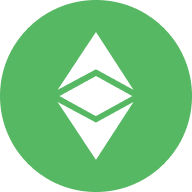Ethereum Classic-hinta
valuutassa USDTietoja kryptosta Ethereum Classic

Ethereum Classic-rahakkeen liikkeeseenlaskijaan liittyvä riski
Vastuuvapauslauseke
OKX ei tarjoa sijoitus- tai omaisuussuosituksia. Sinun on harkittava huolellisesti, sopiiko digitaalisten varojen treidaus tai hallussapito sinulle taloudellisen tilanteesi huomioon ottaen. Ota yhteyttä laki-/vero-/sijoitusalan ammattilaiseen, jos sinulla on kysyttävää omaan tilanteeseesi liittyen. Lisätietoja on käyttöehdoissa ja riskivaroituksessa. Käyttämällä kolmannen osapuolen verkkosivustoa (”TPW”) hyväksyt, että kolmannen osapuolen verkkosivuston käyttöön sovelletaan kolmannen osapuolen verkkosivuston ehtoja. Ellei nimenomaisesti kirjallisesti toisin mainita, OKX ja sen kumppanit (”OKX”) eivät ole millään tavalla yhteydessä kolmannen osapuolen verkkosivuston omistajaan tai operaattoriin. Hyväksyt, että OKX ei ole vastuussa mistään menetyksistä, vahingoista tai muista seurauksista, jotka aiheutuvat kolmannen osapuolen verkkosivuston käytöstäsi. Huomaathan, että kolmannen osapuolen verkkosivun käyttö voi johtaa varojesi menetykseen tai vähenemiseen. Tuote ei välttämättä ole saatavilla kaikilla lainkäyttöalueilla.
Krypton Ethereum Classic hintasuoritus
Oppaat

Luo ilmainen OKX:n tili.
Lisää varoja tilillesi.
Valitse kryptosi.
Ethereum Classic UKK
Toisin kuin Ethereumilla, jolla ei ole tarjonnan rajoituksia, ETC:n tarjonta on rajoitettu 210,7 miljoonalle rahakkeelle. Tämä johtuu siitä, että ETC on ottanut deflatorin lähestymistavan, jossa rahakkeiden epätarvetta odotetaan lisäävän ETC:n hintoja.
ETC:n emissionsalennusohjelma alkaa sen jälkeen, kun lohkoketjuun on lisätty 5 miljoonaa lohkoa. Tuleva lohkopalkkioiden vähennys tapahtuu jonkin aikaa vuoden 2024 kolmannen vuosineljänneksessä.
Osta helposti ETC-rahakkeita OKX:n kryptovaluuttaalustalla. OKX:n spot-treidausterminalin käytettävissä olevia treidauspareja ovat ETC/USDT, ETC/USDC ja ETC/BTC.
Voit myös ostaa ETC:tä yli 99 fiat-valuutalla valitsemallaPikatiosto" -vaihtoehto. Muut suositut kryptorahakkeet, kuten Bitcoin (BTC), Tether (USDT)ja USD-kolikko (USDC), ovat myös saatavilla.
Vaihtoehtoisesti voit vaihtaa olemassa olevia kryptovaluuttojasi, kuten XRP (XRP), Cardano (ADA), Solana (SOL)ja Chainlink (LINK)ETC:lle ilman maksuja ja ilman hinnan liukumaa käyttämällä OKX Convert.
Voit tarkastella arvioituja reaaliaikaisia muuntokursseja fiat-valuutojen, kuten USD:n, EURin, GBP:n ja muiden, ETC:n välillä, vierailemalla OKX:n kryptomuunnintalaskurin. OKX:n korkean likviditeetin kryptopörssi takaa parhaat hinnat krypto-ostoksillesi.
Tutustu tarkemmin Ethereum Classic-rahakkeeseen
Ethereum Classic on hajautettu älysopimuspohjainen verkko, jonka tavoitteena on tulla globaaliksi maksujärjestelmäksi. Ethereum Classic on lähtöisin Ethereum (ETH) -verkosta, ja se käyttää työntodiste (PoW) konsensusmekanismi ja asiakastuki hajautettu sovellus (dApps).
Ethereum Classic syntyi alkuperäisen Ethereum-lohkoketjun jaan jälkeen, koska vuonna 2016 hyökättiin kaikkien aikojen ensimmäiseen hajautettu autonominen organisaatio (DAO), nimeltään DAO. Hyökkääjä käytti hyväkseen DAO:n koodin virhettä ja pääsi tuolloin 50 miljoonan dollarin arvosta ETH:ta.
Hyökkäyksen jälkimainingeissa 97 prosenttia Ethereum-yhteisöstä äänesti luotu a ehdoton haarautuminen haitallisen transaktion kumoamiseksi ja lohkoketjun palauttamiseksi hakkerointia edeltävään tilaan. Ehdoton haarautuminen pelasti siis hyökkäyksen uhrit.
Vaikka suuri enemmistö äänesti ehdoton haarautumisen puolesta, muutamat yhteisön jäsenet olivat eri mieltä filosofisten ja ideologisten erojen vuoksi. He väittivät, että lohkoketjun pitäisi olla muuttumaton, mikä tarkoittaa, että transaktiota ei voida kääntää, pitäen yllä " koodi on laki" ethos.
Ehdoton haarautumisen jälkeen vanha Ethereum-ketju piti lopettaa, mutta erkaantumisen kanssa eri mieltä olleet pitivät verkon hengissä. Tämä johti Ethereum Classicin syntyyn, jonka natiivirahake oli ETC. Vaikka ETH:lla ja ETC:llä oli aluksi useita yhtäläisyyksiä, nämä kaksi verkkoa ovat kasvaneet kauas toisistaan teknisten ominaisuuksien suhteen.
Kuten Ethereum ennen siirtymistään steikkaustodisteeseen (PoS), Ethereum Classic käyttää PoW-konsensusmekanismia, jonka Bitcoin esitteli ensimmäisen kerran. PoW mahdollistaa louhija-pohjaisen validointi- ja päästöjärjestelmän, jossa osallistujat are luo kannuste vahvistamaan, että uusi transaktio ei ole ristiriidassa tai mitätöi lohkoketjussa olemassa olevaa dataa.
Ethereum Classicin mahdollistaman vertaisten välinen (P2P) transaktion lisäksi se tarjoaa myös älysopimustoiminnallisuutta. Sellaisenaan on mahdollista isännöidä rahakea ja rakentaa dApps ETC-lohkoketjuun. Toisin sanoen Ethereum Classicissa lanseeratut sovellukset voivat julkaista ja hallita natiivirahakkeitaan. Tämä järjestelmä on samanlainen kuin Ethereum lohkoketju.
ETC toimii lohkoketjun maksuvaluuttana. Sitä voidaan käyttää maksujen maksamiseen, varsinkin kun toteutetaan älysopimuspohjaisia sovelluksia tai siirrä Ethereum Classic -pohjainen rahake. ETC ankkuroi myös Ethereum Classic -ekosysteemin louhinta-talouden. Verkko palkkiot louhija ETC:llä aina, kun he lisäävät blokatan transaktiota lohkoketjuun.
ETC hinta ja tokenomiikka
Toisin kuin useimmat kryptovaluutat, ETC ei syntynyt julkinen-myynnin tai muiden kryptorahoituskeinojen kautta. Sen sijaan se oli luotu johtuen muuttuvasta Ethereum-maisemasta, joka synnytti kaksi itsenäistä lohkoketjua.
Jaan jälkeen Ethereum Classic päätti toteuttaa joitakin ydinmuutoksia ETC:n päästöjärjestelmään osana suunnitelmia vahvistaa asemaansa itsenäisenä lohkoketjuna. Päästyään yhteisymmärrykseen ETK:n rahapolitiikan toteuttamisesta kehitystiimi käynnisti Gotham Updaten joulukuussa 2017. Tämä päivitä myynti yläraja ETC.
Vaikka ETC:n kokonaistarjonnalle ei ollut virallista enimmäisrajaa ennen Gothamin päivitystä, sen täytäntöönpano rajoitti ETC:n määrän 210,7 miljoonaan rahakeen. Myös ETC:n päästöastetta muutettiin siten, että lohkopalkkio pienenee 20 prosenttia 5 miljoonan blokatan välein.
Tämä siirto vakiinnutti ETC:n deflatoriseksi varaksi. Päästömäärä on suunniteltu pienenemään ajan myötä siinä toivossa, että sen tarjonta laskee vähitellen kysynnän alapuolelle ja nostaa rahaken arvoa.
ETC:n päästövähennysprotokolla toteutti ensimmäisen lohkopalkkion samana päivänä, kun verkko otti käyttöön Gotham updaten. Tämän seurauksena louhijalle myönnettyä lohkopalkkiota alennettiin 5 ETC:stä 4 ETC:hen
Maaliskuussa 2020 toinen ETC-vähennystapahtuma leikkasi lohkopalkkiota vielä 20 prosentilla 3,2 ETC:hen. Huhtikuussa 2022 toteutettiin toinen 20 prosentin lohkopalkkioleikkaus (3,2 ETC:stä 2,56 ETC:hen). 5 miljoonan blokatan päästöaikataulun perusteella seuraava palkkiot -vähennystapahtuma tapahtuu vuonna 2024.
Tietoja perustajista
Ethereum Classic on Ethereumin sisarlohkoketju, sillä molemmat ovat peräisin alun perin vuonna 2015 lanseeratusta Ethereum-lohkoketjusta.
Vuonna 2016, Ethereumin älysopimustoiminnallisuuden perustamisen jälkeen, DAO-niminen protokolla nousi kaikkien aikojen ensimmäiseksi hajautettuksi autonomiseksi organisaatioksi. DAO:n piti sallia osallistujat pooli capitaliin ja päättää yhdessä projektista, jonka he asiakastuki.
DAO:n uutuuden ja sen käyttötapauksen kannattavuuden vuoksi se keräsi 150 miljoonan dollarin arvosta ETH:ta joukkoistamiskampanjansa aikana. Valitettavasti DAO:n älysopimuksessa oli haavoittuvuus.
Alkuperäisen Ethereum-lohkoketjun mainetta uhkaavan tietoturvatapauksen jälkeen suurin osa Ethereumin kehittäjistä ja sidosryhmistä päätti siirtyä haarautuneeseen tai päivitettyyn lohkoketjuun, jossa hakkeroinnin vaikutus eliminoitaisiin. Jotkut louhijat ja käyttäjät päättivät kuitenkin pysyä alkuperäisessä Ethereum-lohkoketjussa, joka myöhemmin muuttui Ethereum Classiciksi verkko.

































